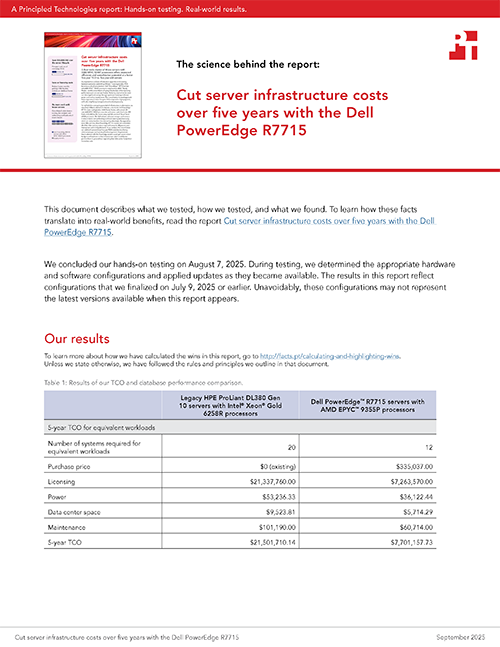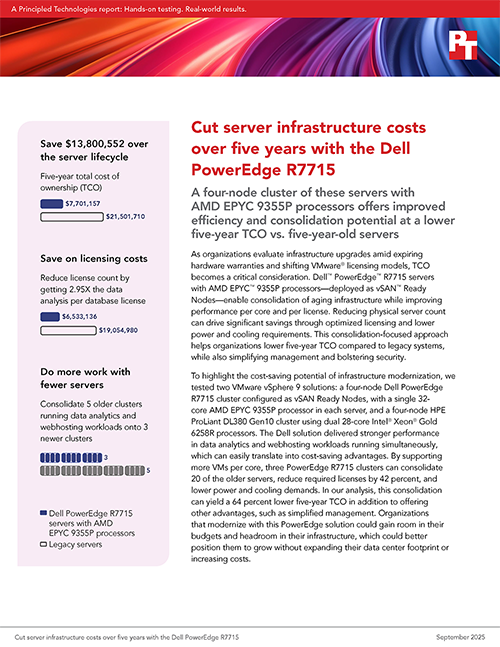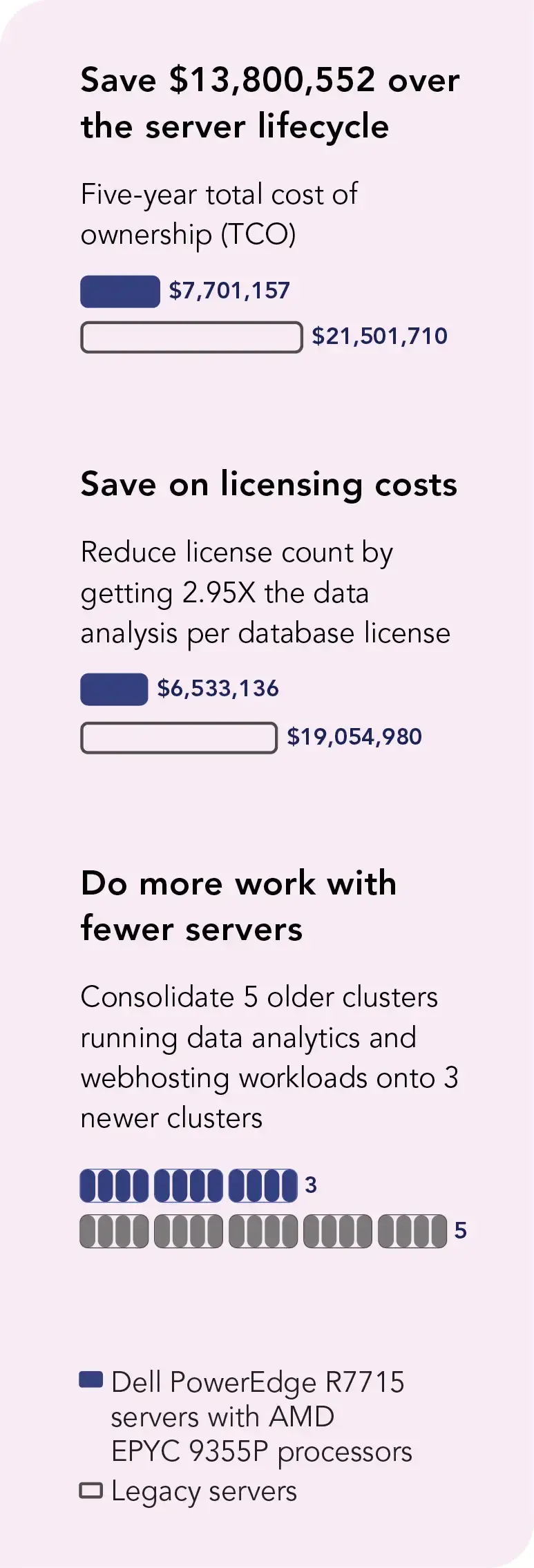
A Principled Technologies report: Hands-on testing. Real-world results.

Cut server infrastructure costs over five years with the Dell PowerEdge R7715

A four-node cluster of these servers with AMD EPYC 9355P processors offers improved efficiency and consolidation potential at a lower five-year TCO vs. five-year-old servers
As organizations evaluate infrastructure upgrades amid expiring hardware warranties and shifting VMware® licensing models, TCO becomes a critical consideration. Dell™ PowerEdge™ R7715 servers with AMD EPYC™ 9355P processors—deployed as vSAN™ Ready Nodes—enable consolidation of aging infrastructure while improving performance per core and per license. Reducing physical server count can drive significant savings through optimized licensing and lower power and cooling requirements. This consolidation-focused approach helps organizations lower five-year TCO compared to legacy systems, while also simplifying management and bolstering security.
To highlight the cost-saving potential of infrastructure modernization, we tested two VMware vSphere 9 solutions: a four-node Dell PowerEdge R7715 cluster configured as vSAN Ready Nodes, with a single 32-core AMD EPYC 9355P processor in each server, and a four-node HPE ProLiant DL380 Gen10 cluster using dual 28-core Intel® Xeon® Gold 6258R processors. The Dell solution delivered stronger performance in data analytics and webhosting workloads running simultaneously, which can easily translate into cost-saving advantages. By supporting more VMs per core, three PowerEdge R7715 clusters can consolidate 20 of the older servers, reduce required licenses by 42 percent, and lower power and cooling demands. In our analysis, this consolidation can yield a 64 percent lower five-year TCO in addition to offering other advantages, such as simplified management. Organizations that modernize with this PowerEdge solution could gain room in their budgets and headroom in their infrastructure, which could better position them to grow without expanding their data center footprint or increasing costs.
Out with the old, in with the new
When business is thriving and your current servers continue to run your database applications, it can be easy to overlook the advantages that new hardware investments might bring. However, as servers age, their performance often falls short of the growing demands of your business’s database workloads—something a successful company cannot afford. Older servers also tend to experience reduced functionality due to hardware and software incompatibilities and are more prone to physical failures, which can consume valuable IT resources with costly maintenance.
Even at their peak, legacy systems may not match the improved performance of modern technology, which features advanced CPUs and updated components unavailable five years ago. Higher performance per core isn’t just about faster processing, though: it enables organizations to run more workloads on fewer servers. In turn, more workloads per server can mean fewer software licenses to manage and pay for.
A practical solution to aging server issues is to consolidate multiple older servers onto fewer, more powerful systems. Performance per core drives licensing consolidation, which helps reduce server count as well as cut costs. By reducing your server footprint, consolidation can offer significant reduction in TCO. Key areas where consolidation delivers savings include:
- Lower software licensing fees by reducing the number of cores needing licenses
- Reduced power and cooling requirements thanks to energy-efficient modern hardware and fewer running servers
- Freed valuable rack and floor space in data centers, maximizing existing infrastructure without extra expansion costs
- Simplified maintenance efforts, as managing fewer servers reduces labor demands and downtime, allowing IT staff to focus on innovation rather than repairs
Consolidate through improved performance
Newer servers, such as the Dell PowerEdge R7715, can typically do many times the work of older servers. This is often due to many factors, including newer servers supporting faster and more resources than the older servers they replace. To show consolidation ability and provide a baseline for TCO analysis, we normalized the two solutions on VM count for data analytics workloads, i.e., how many clusters would it take for each solution to support the same number of OLAP workloads, each running in a VM. To calculate this number, we used the performance data from our TPROC-H data analysis (see Table 1).
See the sections “Boost analytics to unlock timely insights” and “Handle daily web traffic simultaneously with data analytics” for further discussion about performance.
| Dell PowerEdge R7715 cluster | Legacy cluster | Percentage win for Dell cluster | |
|---|---|---|---|
| Data analytics (TPROC-H) VMs | 20 | 12 | 66% |
| Data analytics (TPROC-H) query sets per hour | 354.67 | 209.7 | 69% |
| Webhosting VMs | 4 | 4 | — |
| Average webhosting transaction per second | 442 | 150 | 194% |
By analyzing the performance differences we saw in testing, we found that replacing five four-node clusters of legacy servers with three four-node clusters of PowerEdge R7715 servers with AMD EPYC 9355P processors could reduce the required number of servers to handle an equivalent amount of data analysis and webhosting workloads. This migration can enable an organization to reduce server count dramatically, which could thus deliver the many aforementioned benefits of consolidation.
As Figure 1 shows, 12 four-node PowerEdge R7715 clusters attaining the same level of performance we saw in testing could do the work of 20 older HPE ProLiant DL380 Gen10 servers. This consolidation is based on the query-sets-per-hour metric. See the science behind the report for results.
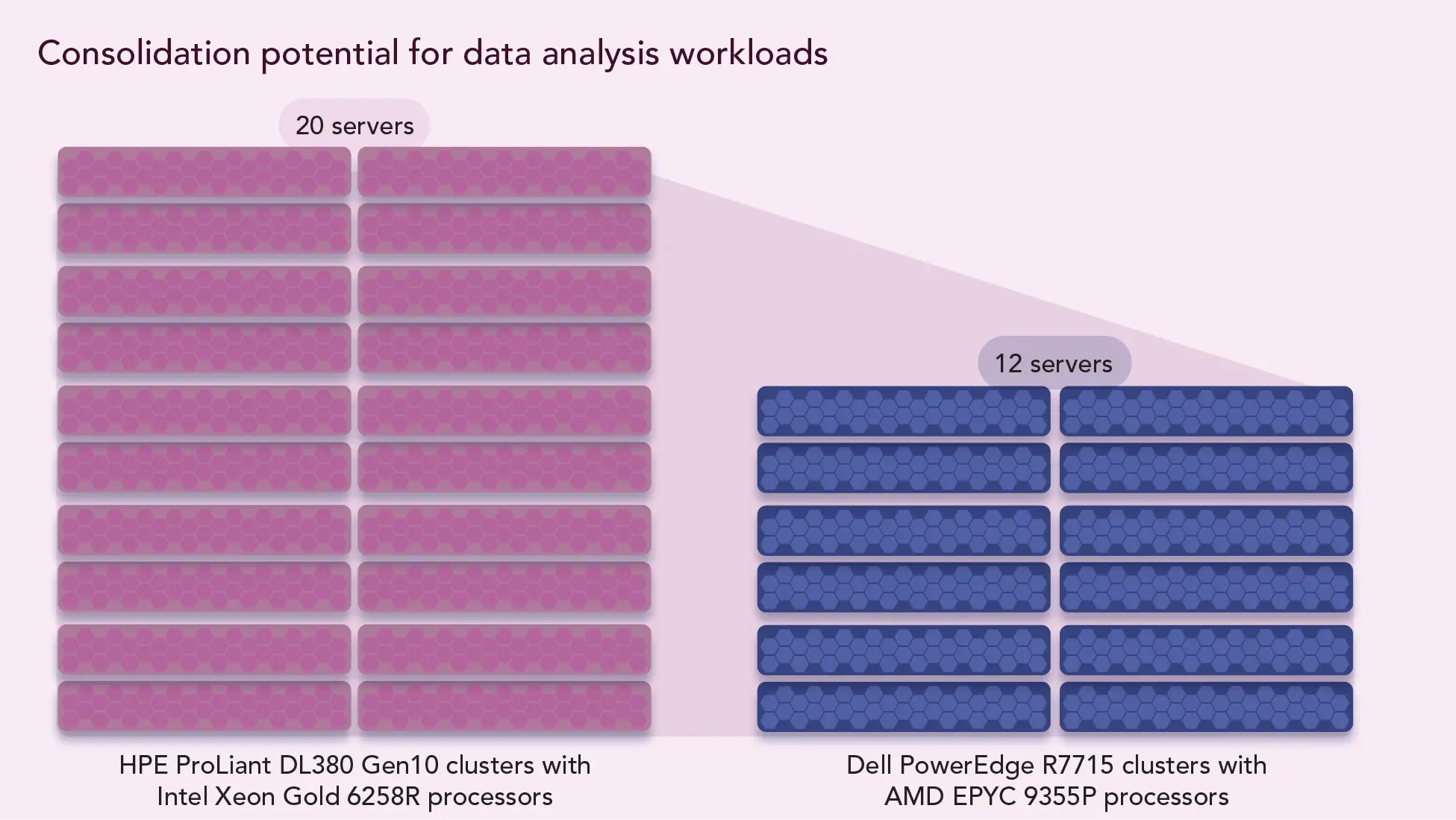
VMware licenses VMware vSphere 9 on a per-core basis, with a licensing minimum of 16 cores. The older server we tested required 56 VMware vSphere 9 licenses because it contained two 28-core Intel Xeon Gold 6258R processors. Each PowerEdge R7715 had one 32-core AMD EPYC 9355P processor, requiring 32 vSphere licenses. However, scaling the licenses to match our data analysis consolidation scenario (20 legacy servers down to 12 PowerEdge R7715 servers) would bring the number of per-core VMware licenses from 1,120 to 384, which means 736 fewer licenses—a nearly two-thirds reduction—to handle roughly the same amount of online analytical processing (OLAP) work. Fewer licenses would cut operating costs, thus helping an organization’s bottom line.
When we combine the consolidation factor with the improved power efficiency of the Dell and AMD solution, the reduction in power usage—and your monthly electricity bill—become dramatic. Compared to the 20 legacy servers you would need to support the same number of VMs, the three four-node Dell PowerEdge R7715 clusters with AMD EPYC 9355P processors would reduce power usage by 32 percent.
Save $13,800,552 over five years from consolidation
As our consolidation scenario shows, matching the number of workloads (i.e., VM count) for three four-node Dell PowerEdge R7715 clusters requires 20 legacy servers in five clusters.
Figure 2 shows the five-year TCO we calculated for these near-equivalent-performing solutions. We estimate that consolidating 20 older servers onto 12 PowerEdge R7715 servers with AMD EPYC 9355P processors could save organizations up to $13,800,552.42 USD in operating costs over five years, a 64 percent reduction.
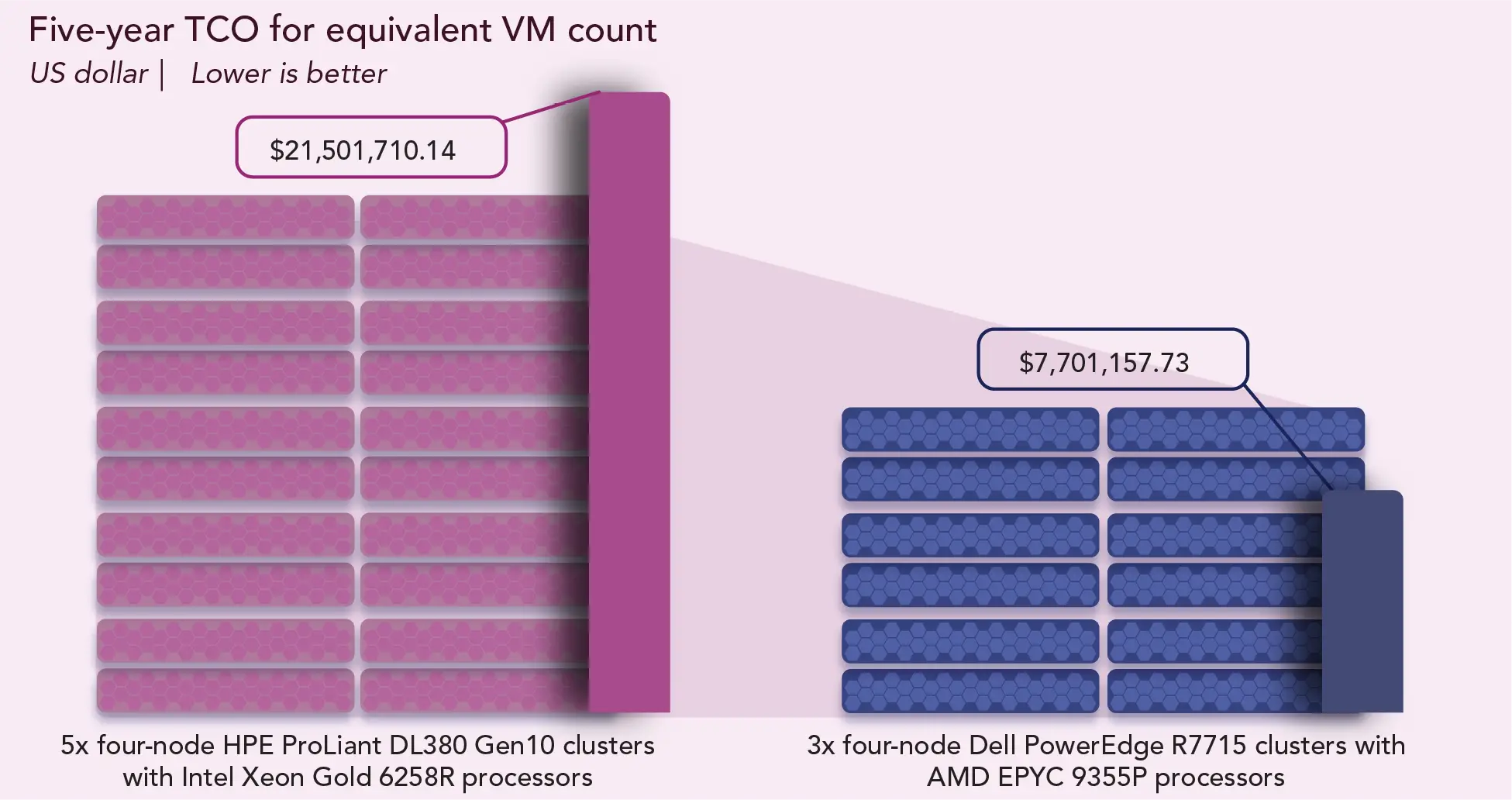
Table 2 breaks down our five-year cost calculations for both solutions. For further details, including the specific assumptions we made to arrive at these calculations, see the science behind the report. Note: As with any TCO estimate, your cost savings will vary depending on several factors.
| Five-year TCO summary for migrating data analysis workloads from five four-node legacy servers to three four-node PowerEdge R7715 clusters | ||
|---|---|---|
| 5x four-node HPE ProLiant DL380 Gen10 clusters | 3x four-node Dell PowerEdge R7715 clusters | |
| Number of systems required for equivalent workload levels | 20 | 12 |
| Purchase price | $0 (existing) | $335,037.00 |
| Licensing | $21,337,760.00 | $7,263,570.00 |
| Power | $53,236.33 | $36,122.44 |
| Data center space | $9,523.81 | $5,714.29 |
| Maintenance | $101,190.00 | $60,714.00 |
| Five-year TCO | $21,501,710.14 | $7,701,157.73 |
License costs include several software suites that are licensed per physical core:2, 3, 4
- SQL Server 2022 Enterprise: $15,123.00 per two-core license pack
- Windows Server 2025 Datacenter: $6,771.00 per 16-core license pack
- VMware vSphere Foundation 9: $190 annual subscription cost per core
As noted, the legacy server had more cores (24) than the PowerEdge R7715, so the 20 legacy servers would require licensing for 1,120 cores to match the VM count of the PowerEdge cluster. Consolidating would reduce the core count, and thus licensing costs.
To calculate the power costs, we used both active and idle wattage from testing to calculate five years of power consumption using the average energy cost in the US as of May 2025: $.1747 per kwh.5 The three four-node PowerEdge clusters would use 32 percent less power than the estimated 20 legacy servers supporting the same workload levels. The total costs for the energy the legacy servers consume would thus be higher. These costs also account for cooling infrastructure at the data center level.
To evaluate space savings, we compared data center footprint costs per rack, factoring in consolidation and rack space requirements. The 20 legacy servers would occupy 40U of space compared to the 24U required by the three four-node PowerEdge clusters, so the rack space cost for the PowerEdge setup would be 40 percent lower.
Our maintenance cost calculation assumed one IT administrator manages 100 servers. Based on the number of servers—12 for the PowerEdge clusters and 20 legacy servers—we estimated the number of admins necessary to perform maintenance tasks. We then multiplied that number by the average annual salary of $101,190.00 for a network and computer systems administrator to determine labor costs.6
Boost analytics to unlock timely insights
Increasing the speed of your data analytics capabilities can lead to more accurate predictions and better informed strategies for your business. In our testing, the four-node Dell PowerEdge R7715 cluster with AMD EPYC 9355P processors completed 20 data analysis workloads, one per VM, in the same time as the legacy cluster with Intel Xeon Gold 6258R processors completed its 12 data analysis workloads (also one per VM).
Migrating data analysis workloads to the PowerEdge cluster in this cluster-to-cluster scenario would mean better performance at scale due to the 66 percent increase in supported workloads. The performance is particularly compelling when you consider that the PowerEdge R7715 server had 42 percent fewer cores—it did more with less.
Figure 3 shows the projected query sets per hour based on our results from TPROC-H testing. Due to the higher workload count and faster performance, the four-node PowerEdge cluster can complete 69 percent more query sets in an hour than the legacy cluster can complete (354 vs. 209 total query sets). See the science behind this report for detailed results.
The closer you are to processing data in real time at scale, the more value you can extract—empowering both immediate decision-making and long-term strategic planning based on up-to-date insights.

Measured by performance per SQL Server license, the Dell PowerEdge R7715 cluster can deliver 2.95 times more query sets per hour for each license compared to the legacy environment. This higher efficiency demonstrates how fewer cores supported more workloads, which in turn drives a 42 percent reduction in licensing costs across vSphere 9, SQL Server, and Windows Server. The result is a Dell PowerEdge R7715 cluster that delivers stronger data analytics performance while lowering ongoing software expenses.
Handle daily web traffic simultaneously with data analytics
A 2023 HubSpot survey found that 46 percent of business websites attract 1,001 to 15,000 monthly visitors, while another 19 percent draw 15,001 to 50,000.7 At the top end of that range, 50,000 monthly visits equal just over 1,600 visits per day. Linking these visitor benchmarks to workload testing highlights how measured performance can translate into business-ready capacity.
To test WordPress workload performance, we ran the Siege benchmark alongside our data analysis workload testing. This also demonstrated how well each cluster could handle both workloads simultaneously. A server cluster that delivers more WordPress TPS can support more simultaneous connections to your websites, which means supporting more website visitors. Table 3 shows that the four-node Dell PowerEdge R7715 cluster with AMD EPYC 9355P processors supported more TPS than the legacy cluster. To put that into perspective, if we consider each TPS represents one visitor action, the total TPS capacity of the Dell PowerEdge R7715 cluster with AMD EPYC 9355P processors could handle the typical traffic volume of about two-thirds of U.S. business websites, based on average visitor data.8
| 4x Dell PowerEdge R7715 servers with AMD EPYC 9355P processors | 4x Dell PowerEdge R7715 servers with AMD EPYC 9355P processors | |
|---|---|---|
| Average WordPress TPS | 442 | 150 |
Achieve more work per watt for cost savings
A September 2024 IDC report stressed the importance and scale of data center power usage by stating that electricity remains the single largest ongoing expense for data center operators, accounting for 46 percent of total spending in enterprise facilities and 60 percent in service-provider environments.9 This cost impact makes performance per watt a helpful metric for evaluating infrastructure investments.
We assessed the average host performance per watt of both clusters while running the data analysis and webhosting workloads (see Figure 4). The Dell cluster delivered up to three times the power efficiency of the legacy cluster in performance per watt.

Conclusion
As organizations face hardware warranty expirations and changing VMware licensing requirements, upgrading IT infrastructure becomes critical to managing power, cooling, and operational challenges. Migrating data analysis and webhosting workloads to four-node Dell PowerEdge R7715 clusters with AMD EPYC 9355P processors can help organizations overcome aging infrastructure challenges, such as high maintenance and hardware limitations, with fewer, more powerful servers.
Thanks to improved performance per core and greater workload density, the PowerEdge R7715 cluster can deliver significant cost savings through server consolidation, lower licensing fees, reduced power use, and a smaller data center footprint—all contributing to a 64 percent lower five-year TCO, a savings of over $13 million USD. In addition to the lower TCO, migrating to PowerEdge R7715 four-node clusters can enable you to run more VMs, consume less power, and use less rack space compared to a legacy environment. These reductions would translate into operational savings across licensing, facilities, and ongoing management.
Performance gains from our cluster-to-cluster comparison compound the efficiency. The four-node PowerEdge R7715 cluster we tested supported 66 percent more SQL VMs while reducing SQL licensing costs by 42 percent and can run 40 percent more query sets per hour while achieving more than three times the TPS on webhosting workloads. This level of throughput means IT teams can consolidate more workloads on fewer systems without sacrificing responsiveness—translating directly into higher utilization per license dollar and per watt consumed. Consolidating onto PowerEdge R7715 clusters could help control two sources of significant data center costs—licensing and energy—while simultaneously delivering better workload performance and freeing budget for strategic initiatives. Choosing this path to data center modernization can help your organization remain competitive as demands grow.
- Dell, “Spec Sheet - PowerEdge Rack series,” accessed August 18, 2025, https://www.delltechnologies.com/asset/en-us/products/servers/technical-support/poweredge-rack-series-spec-sheet.pdf.
- Microsoft, “SQL Server 2022 pricing and licensing,” accessed August 18, 2025, https://www.microsoft.com/en-us/sql-server/sql-server-2022-pricing.
- Microsoft, “Windows Server pricing and licensing,” accessed August 18, 2025, https://www.microsoft.com/en-us/windows-server/pricing.
- WintelGuy.com, “VMware Licensing Calculator (unofficial),” accessed August 18, 2025, https://wintelguy.com/vmware-licensing-calc.pl.
- U.S. Energy Information Administration (EIA), “Electric Power Monthly,” accessed August 21, 2025, https://www.eia.gov/electricity/monthly/epm_table_grapher.php?t=table_es1a.
- U.S. Bureau of Labor Statistics, “Occupational Employment and Wage Statistics Query System,” August 21, 2025, https://data.bls.gov/oes/#/industry/000000.
- HubSpot, “How Many Visitors Should Your Website Get? [Data from 400+ Web Traffic Analysts],” accessed August 21, 2025, https://blog.hubspot.com/blog/tabid/6307/bid/5092/how-many-visitors-should-your-site-get.aspx.
- HubSpot, “How Many Visitors Should Your Website Get? [Data from 400+ Web Traffic Analysts].”
- IDC, “IDC Report Reveals AI-Driven Growth in Datacenter Energy Consumption, Predicts Surge in Datacenter Facility Spending Amid Rising Electricity Costs,” accessed August 22, 2025, https://www.idc.com/getdoc.jsp?containerId=prUS52611224.
This project was commissioned by Dell Technologies.
September 2025
Principled Technologies is a registered trademark of Principled Technologies, Inc.
All other product names are the trademarks of their respective owners.
Principled Technologies disclaimer

Principled Technologies is a registered trademark of Principled Technologies, Inc.
All other product names are the trademarks of their respective owners.
DISCLAIMER OF WARRANTIES; LIMITATION OF LIABILITY:
Principled Technologies, Inc. has made reasonable efforts to ensure the accuracy and validity of its testing, however, Principled Technologies, Inc. specifically disclaims any warranty, expressed or implied, relating to the test results and analysis, their accuracy, completeness or quality, including any implied warranty of fitness for any particular purpose. All persons or entities relying on the results of any testing do so at their own risk, and agree that Principled Technologies, Inc., its employees and its subcontractors shall have no liability whatsoever from any claim of loss or damage on account of any alleged error or defect in any testing procedure or result.
In no event shall Principled Technologies, Inc. be liable for indirect, special, incidental, or consequential damages in connection with its testing, even if advised of the possibility of such damages. In no event shall Principled Technologies, Inc.’s liability, including for direct damages, exceed the amounts paid in connection with Principled Technologies, Inc.’s testing. Customer’s sole and exclusive remedies are as set forth herein.

 Twitter
Twitter Facebook
Facebook LinkedIn
LinkedIn Email
Email